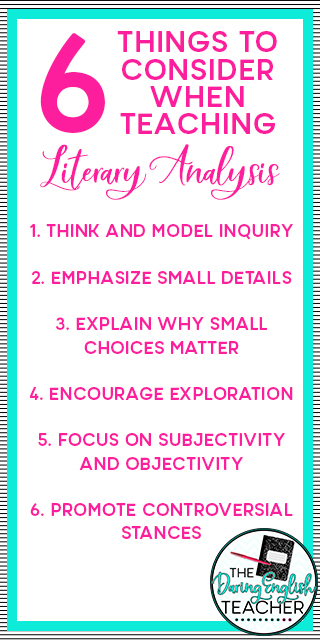One of the most important things you can teach your students is good literary analysis skills. Your students will be critically reading texts in high school, college, graduate school, and in their careers. It’s necessary to cultivate analytical ability as early as possible. If you are looking at how to teach literary analysis, sere are six ways to enhance the literary analysis curriculum for all ages.
How to Teach Literary Analysis: Think Aloud and Model Inquiry 
The process of literary analysis is fraught with difficulty, even for the most seasoned critic. How can we expect students to “get” literary analysis without seeing it in action?
Hint: it’s tough.
As such, a reliable way to gain an understanding of the fluid process of close reading and literary analysis is to model it for your students. To do this, analyze a relevant text in front of the class to show your process. It may seem uncomfortable, but don’t prepare yourself for this exercise beyond reading the text you’re analyzing- you want to give your students an authentic experience so they can really see the steps required.
If you have an overhead projector, document camera, or similar technology, this would be the time to use it.
How to Teach Literary Analysis: Emphasize Small Details
When teaching literary analysis, a pattern appears: students’ analysis looks more like summaries. A way to remedy this is to remind and reinforce to them that the small details are especially important when analyzing a text.
That’s not to say large plot points are less important; there is merely more to draw from when considering the small stuff in a written work. They must move beyond what’s “interesting” and focus on what’s “significant,” and the small details help students achieve this state.
How to Teach Literary Analysis: Explain Why Small Choices Matter
To that end, when digging into the nitty-gritty of analysis, we run into structural details. These authorial details, while seemingly arbitrary, are often intentional. A period here, a semi-colon there- each creates a different meaning and a different context. These choices can prompt and support intellectual arguments if only our students recognize them.
How to Teach Literary Analysis: Encourage Exploration
Some of the best analytical essays were born of a question. Allow and encourage your students to explore the text. They should be able to pursue an idea and have it fail, to rewrite and redo, to ask questions that may not seem relevant, and to find a part of the text that speaks to them. Only then will they create a quality paper.
Remind your students constantly that for the most part, there are no wrong answers. The only stipulation is that the claim needs to be backed up by sufficient textual evidence and discussion of the evidence.
How to Teach Literary Analysis: Subjectivity and Objectivity
Discuss the differences between subjectivity and objectivity and how they relate to writing. Contrary to popular belief, the purpose of literary analysis is not “what does the text mean to me.” However, subjectivity does have a place in literary analysis. It’s finding the balance between objectivity and subjectivity that many students have issues with, and it’s important to define these terms and their usage in context at the beginning of the year.
How to Teach Literary Analysis: Promote Controversial Stances
An argument that is accepted widely as “true” runs the risk of sounding like a retelling of the text. Students must avoid this. The most evident way to do so is to write about something that has multiple, plausible opposing sides. Find the controversy in the text, and have students analyze the controversy.
You might also be interested in this blog post: 15 Literary Analysis Questions to Ask Your Students.
Literary Analysis Teaching Resources:



